
My boon childhood friend was Jimmy Rutherford, whom I met in late 1963. I know this because I recall discussing the Kennedy assassination with him a week or so after we first met. Jimmy and I were next-door neighbors living on Robinson Street in the Silver Lake district of Los Angeles. One day I was playing around in my yard with a wicker picnic basket (I think I was filling it with dirt, actually), listening to the current hit "Puff, the Magic Dragon" by Peter, Paul and Mary playing on a radio sitting near an open window. I noticed this kid my age (seven) on the other side of the chain link fence, and struck up a conversation. One thing led to another and we became fast friends.
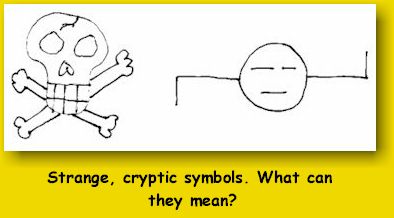 Jimmy's family - his mother, grandmother and sister - rented the property next door to us, the back yard of which had a neat crawlspace under the house which served as a sort of hiding place. I remember scrawling crayon-drawn images of Disneyland down there, or we used to pretend it was a Disneyland ride; I'm not sure. We shared an enthusiasm for the Disneyland dark house rides (Peter Pan, Mr. Toad's Wild Ride, etc.) and created some of our own by crawling though boxes set up end to end. In these boxes we always drew two images which had a mighty totemic power and significance for us: a skull and crossbones and an odd, Mojave Indian-looking face which somehow represented a mine, as I recall. (In our dark house rides one would be in danger of traveling through a collapsing mine shaft, which was represented by the ride operator throwing himself onto the box occupied by the rider.) I also remember cutting these symbols out of paper and suspending them from the tree branches in his back yard, like something out of The Blair Witch Project.
Jimmy's family - his mother, grandmother and sister - rented the property next door to us, the back yard of which had a neat crawlspace under the house which served as a sort of hiding place. I remember scrawling crayon-drawn images of Disneyland down there, or we used to pretend it was a Disneyland ride; I'm not sure. We shared an enthusiasm for the Disneyland dark house rides (Peter Pan, Mr. Toad's Wild Ride, etc.) and created some of our own by crawling though boxes set up end to end. In these boxes we always drew two images which had a mighty totemic power and significance for us: a skull and crossbones and an odd, Mojave Indian-looking face which somehow represented a mine, as I recall. (In our dark house rides one would be in danger of traveling through a collapsing mine shaft, which was represented by the ride operator throwing himself onto the box occupied by the rider.) I also remember cutting these symbols out of paper and suspending them from the tree branches in his back yard, like something out of The Blair Witch Project.
Jimmy was tall for his age, and we got along famously. Watching existing 8mm home movies of us, we look like a couple of little monkeys, grabbing, punching, hugging, etc. at each other as boys that age will. (Perhaps you can see that in the picture below.) We were inseparable. After a walk home from school I recall sitting in his bathroom talking with him while he was on the throne, a level of togetherness my daughters find bizarre when I tell them these stories…
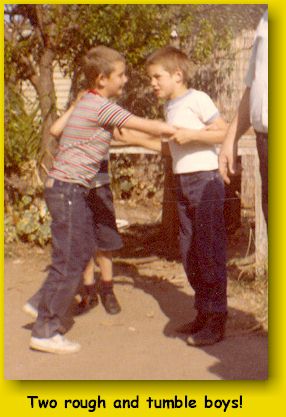 We had incredible imaginations. Jimmy and I reasoned that whenever something bad happened to one of us - a fall from a bike, something stolen, etc. - it was a fault of the shadowy Black Cat Club, who trailed us and tried to thwart us whenever the possibility arose. Walking home from Micheltorena Avenue Elementary School we concocted elaborate situations. Once, I was quite taken aback by Jimmy blurting, quite out of the blue, "Do you remember how after we first landed here on earth and walked out of our spaceship you told me to forget that we were from another planet? I did for the longest time. I just now remembered it!" I realized then that I was in the presence of a master fabulist possessing a first-rate imagination, a fact I would observe again when we took to writing our own comic books.
We had incredible imaginations. Jimmy and I reasoned that whenever something bad happened to one of us - a fall from a bike, something stolen, etc. - it was a fault of the shadowy Black Cat Club, who trailed us and tried to thwart us whenever the possibility arose. Walking home from Micheltorena Avenue Elementary School we concocted elaborate situations. Once, I was quite taken aback by Jimmy blurting, quite out of the blue, "Do you remember how after we first landed here on earth and walked out of our spaceship you told me to forget that we were from another planet? I did for the longest time. I just now remembered it!" I realized then that I was in the presence of a master fabulist possessing a first-rate imagination, a fact I would observe again when we took to writing our own comic books.
Elsewhere in Avocado Memories I describe our interest in the Universal monsters - a major fad among kids at the time - and with drawing comic books, another shared interest. Another big influence for us was the Beatles and Beatlemania, which came along as a sort of national emotional relief after the pain of the Kennedy assassination. Our exposure to the Beatles came about mainly because Jimmy's sister Kathy was a teenage girl and therefore susceptible to the hysteria.
Kathy was over at our house (wearing a white blouse with a beetle design on it!) when they made their 9 February 1964 debut on the "Ed Sullivan Show." I was perplexed by the whole thing, and Jimmy and I reacted with an intense, boyish dislike of the four. That didn't last long. We were eventually won over to the Beatles by the intense publicity machine working on their behalf, and later came to idolize them. I still remember the feeling of intense pride I had when Mom bought me my first Beatles fan magazine from a supermarket. Jimmy and I had favorite Beatles: mine was John and Jimmy's was Paul. We read in the fanzines that Paul's favorite color was black and that John's was blue, so Jimmy and I accordingly got our moms to buy us black and blue swim trunks and "Jap flaps" (rubber foam sandals, so called because at the time they were a cheap Japanese import item found in grocery stores). Our outdoor play sometimes involved being the Beatles in Liverpool.
 We saw "Hard Day's Night" a number of times and bought Beatles albums. In fact, listening to the soundtrack of "Hard Day's Night" puts me in a time machine. My hair feels wet from just coming out of the pool during the summer of 1964, and I can taste cheap Shasta sodas, my feet burn from walking on a hot Robinson Street sidewalk without my Jap flaps, etc.
We saw "Hard Day's Night" a number of times and bought Beatles albums. In fact, listening to the soundtrack of "Hard Day's Night" puts me in a time machine. My hair feels wet from just coming out of the pool during the summer of 1964, and I can taste cheap Shasta sodas, my feet burn from walking on a hot Robinson Street sidewalk without my Jap flaps, etc.
Kathy was fun. She once took us to a movie in Hollywood, which became something of a cult object for us: the Roger Corman adaptation of Edgar Allen Poe's "Masque of the Red Death." (Jimmy and I got a kick out of the poster art: "His nose is a girl's butt!") I wanted to go see the Hammer film "Frankenstein," but Kathy insisted on seeing the other film because it starred Jane Asher, Paul McCartney's girl friend. (She was actually Paul's mistress, but this was in a time when the news media took care not to debunk idols.) Kathy, the vice-president of one of the many Beatles fan clubs in L.A., felt the sort of extreme jealousy and hatred of her rival Jane Asher that could only make sense to a teenage girl. I remember her once saying, "I'd kill Paul before I'd let anyone else have him!" Despite the emotional angst, Jimmy and I loved the Masque. It was a happy discovery that the film was just as good when I watched it again on videotape in 1981 as it was when I saw it as an unsophisticated child in 1964.
Dad was in and out of the hospital during these days as a result of alcoholism. One night he started to hemorrhage badly and had to be taken to the hospital. He very nearly died, and it was then that he quit drinking. During his hospital stay, however, Mom did something very gutsy - she bought a house! 1631 North Lincoln Street, Burbank, California - which I describe in excruciating detail elsewhere in these pages. From his hospital bed Dad gave a grudging approval - how could he prevent it? - and on February 13th, the day before St. Valentine's Day in 1965, Mom moved us in. (Dad was still in the hospital.) Sometime after we moved from Robinson Street, Jimmy's family moved as well.
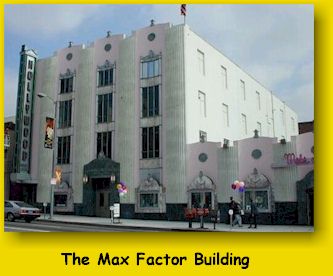 Jimmy and I were not to be separated, however. My mom used to take me to visit him for sleepovers in Hollywood, and sometimes he slept over at our house in Burbank. For awhile, Jimmy lived behind the famous Max Factor building near the intersection of Highland and Hollywood Blvd. Our playground was therefore Hollywood Boulevard and the Egyptian theater, where we'd watch "The Ten Commandments" repeatedly. Heroic leading men come and go, but for me (and, I suspect, Jimmy), there was no one like Charlton Heston. Bigger than life.
Jimmy and I were not to be separated, however. My mom used to take me to visit him for sleepovers in Hollywood, and sometimes he slept over at our house in Burbank. For awhile, Jimmy lived behind the famous Max Factor building near the intersection of Highland and Hollywood Blvd. Our playground was therefore Hollywood Boulevard and the Egyptian theater, where we'd watch "The Ten Commandments" repeatedly. Heroic leading men come and go, but for me (and, I suspect, Jimmy), there was no one like Charlton Heston. Bigger than life.
We spent hours on Saturdays walking up and down Hollywood Boulevard, making a general nuisance of ourselves to the storeowners. At the time (1966/1967) the area had become rather run down, and no longer possessed the glamour it had during the 1930s and 1940s. (It would get far worse in the Seventies.) Elaborate, deteriorating neon signage and Art Deco storefronts from thirty years before attested to this. The Sixties were in full swing, and the whole area had a revolutionarily druggie, disreputable feel to it. All sorts of odd-looking people could be seen there, and one had the impression of danger. Nearby, a used bookstore sold old Playboys and had a nude Marilyn Monroe calendar on display.
For unsupervised boys, naturally, all of this was sheer heaven.
We loved a big toy store that had the coveted Batman utility belt in the front window - which I finally got. One restaurant had a cheesy window display of what was purported to be a million dollars in cash and gold. Yeah, right. Jimmy loved a particular taco stand… until he got a wicked case of food poisoning at the place. Nickel and dime places - afterwards called "schlock shops" - had rolls of off-brand Life-Savers in a wooden bin, which we'd cheerfully steal when we walked by. The Army-Navy surplus place had all sorts of fascinating gear. And there were always places that had provocative window displays; I distinctly recall one that had the nude John and Yoko LP cover. What a let-down! What on earth got into my favorite Beatle?
The classiest and most indisputably reputable store on Hollywood Boulevard was Pickwick Books; my mother used to take me there to buy Doctor Dolittle adventures, which I still have. Since it was a place one could take one's family to, Jimmy and I didn't bother with it. The Hollywood Wax Museum and Graumann's Chinese Theater were far more interesting. (So was Raquel Welch; we saw her in "Fantastic Voyage" at the Chinese in 1966.) In the courtyard of the Chinese theater there used to be one of those futuristically-designed wax injection molding machines that, for some change, produced a hot wax replica of the theater. Jimmy and I used to be fascinated by the fact that the model came out hot. We bought and broke a number of these.
 Our favorite haunt was the Cherokee Bookstore - specifically the section upstairs, where the old comic books were sold. Hundreds of 1950's and 1960's comics were filed away in boxes for sale for 25 or 50 cents each. The really good stuff, however, the 1940's issues, were in plastic bags on the walls or displayed under a glass case. I distinctly recall viewing the first issue of Superman given pride of place under the glass and thinking, "Who on earth could afford paying $750 dollars for an old comic book?" I'm sure somebody did, however, and has seen his investment improve in value greatly since then.
Our favorite haunt was the Cherokee Bookstore - specifically the section upstairs, where the old comic books were sold. Hundreds of 1950's and 1960's comics were filed away in boxes for sale for 25 or 50 cents each. The really good stuff, however, the 1940's issues, were in plastic bags on the walls or displayed under a glass case. I distinctly recall viewing the first issue of Superman given pride of place under the glass and thinking, "Who on earth could afford paying $750 dollars for an old comic book?" I'm sure somebody did, however, and has seen his investment improve in value greatly since then.
The upper floor of Cherokee Books was presided over by a countercultural-looking fellow named Burt (we referred to him as Bart, which conveniently rhymed with "fart"), who used to annoyingly practice at playing a flute. An early predecessor of the Comic Book Guy on the Simpsons, he sat in an area surrounded by really clever adaptations of the Phantom plastic model made up to look like comic book characters not commercially available as plastic models (Green Lantern, the Golden Age Flash, etc.). One had to suffer through the flute playing to admire them. Like the Simpsons character, Burt had a haughty, dismissive attitude about his young clientele. We hated him, we admired him, we wanted his comic books and those models.
These days I feel guilty and resentful whenever I think about Cherokee Books. Here's why: By the time I quit collecting comic books at about age fourteen I had something like 1,100 of them. Quite a few of these were valuable and in excellent condition - the first issues of Spider-Man, many early issues of the Fantastic Four, the first twenty issues of X-Men, Iron Man's origin issue, etc. But when I was nineteen and a big, bad Marine I decided that such things were childish. I wanted to unload them. So, in 1975 it was back to Cherokee Books, where Burt and an associate (at least I think it was Burt) offered me the lordly sum of about $140 for them all. Being young and stupid, I took it. Fool! Idiot! Dolt! Not only is that collection worth tens of thousands of dollars today (or more!), what really burns me is that I sold my childhood dreams and fantasies. This really hit home when my son was about ten and a comic book fan himself. To really rub salt in the wound, he loved the X-Men. If I could step into a time machine and offer a younger version of myself advice, high up on the list would be, "Save those comic books!"
(Note: A reader, Simon, found a great old photograph of Burt in action. Thanks, Simon! And here's another article mentioning Burt Blum.)
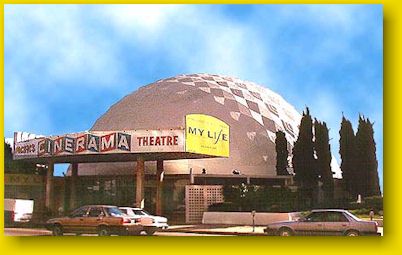 There's no missing the Cinerama Dome building in Hollywood; it is unique. On one sleepover at Jimmy's in 1965 or 1966, we walked to the dome and found a great World War II mock battlefield set up to the right of those cypress trees, promoting "The Battle of the Bulge." There was fake snow on the ground, artillery pieces, pillboxes and occasional flashes of light doubling as explosions synchronized with a full audio track. It made for a memorable playground! I forget which one of us was the Germans and which the Americans, but I do recall breaking something or another while we were playing, and deciding it was time to flee the scene of battle before a hostile Cinerama Dome employee discovered us.
There's no missing the Cinerama Dome building in Hollywood; it is unique. On one sleepover at Jimmy's in 1965 or 1966, we walked to the dome and found a great World War II mock battlefield set up to the right of those cypress trees, promoting "The Battle of the Bulge." There was fake snow on the ground, artillery pieces, pillboxes and occasional flashes of light doubling as explosions synchronized with a full audio track. It made for a memorable playground! I forget which one of us was the Germans and which the Americans, but I do recall breaking something or another while we were playing, and deciding it was time to flee the scene of battle before a hostile Cinerama Dome employee discovered us.
I especially remember the December 1966 Santa Claus Lane Parade, which proceeded down our Hollywood Boulevard stomping grounds. It was always televised, and this year one or both of our mothers had the happy idea of having me spend the night at Jimmy's so the both of us could tramp around the float preparation area unsupervised and gawk at the celebrities. It was a long, cold and memorable evening among the stars - and the noisy outdoor arcs that threw shafts of light onto the evening sky. (Staring into one of these was a test of manhood.) The parade itself was far less interesting than milling around on our own.
That night I brought the Kodak Instamatic and took some shots!
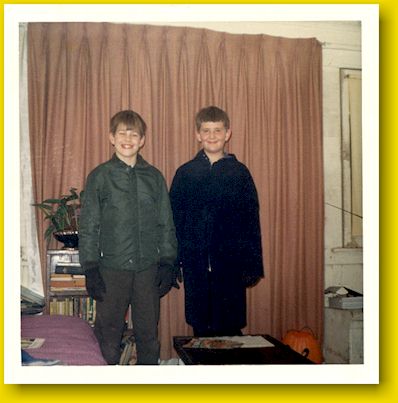
Here we are, dressed warmly, ready for a night on the town. I'm in green and Jimmy's in blue. There is an old Batman comic on the coffee table. That planter behind me was once admired by my father during a visit - so Jimmy's mother gave it to him and it graced our house for a time.
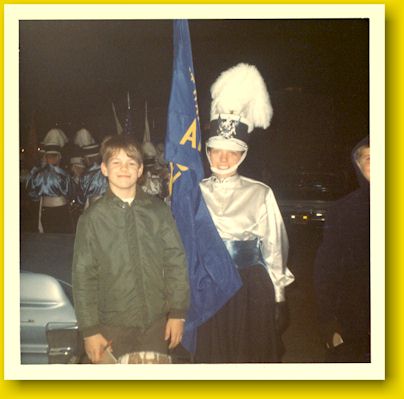
Here I am, autograph paper and pen in hand, posing with a pretty young flag bearer from some high school. Why? I have no idea. I guess I figured that everyone taking a part in the parade that night was a star. Half of Jimmy can be seen on the right.
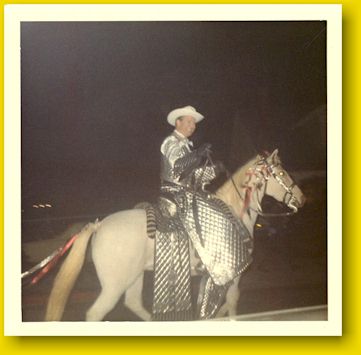
This is George Putnam, a Los Angeles newscaster who had a famous, somewhat bombastic announcing style. (I think he may have been the model for the Ted Baxter character on "the Mary Tyler Moore Show.") Anyway, he was a regular in area parades, and here he is wearing something shiny and metallic that Iron Man wouldn't be ashamed to wear. Note also the pistol in the holster. I wonder if it was loaded.
Come to think of it, an armed newscaster dressed like a cowboy riding a horse down Hollywood Boulevard is a sort of odd thing, isn't it?
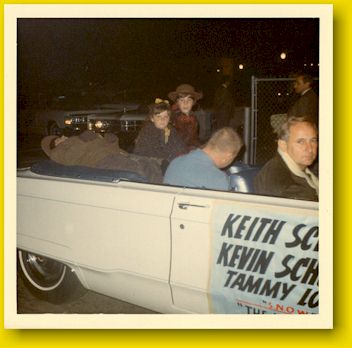
Continuing the Western theme, here are Kevin Schultz, his brother Keith Schultz and Tammy Locke, who starred in a now-forgotten TV show called "The Monroes," which, as I recall, was sort of a predecessor of "Little House on the Prarie." Kevin or Keith, I'm not sure which, is sort of zoning out. Tammy looks somewhat annoyed about my flash going off. The fellow in the passenger seat doesn't look very amused, either.
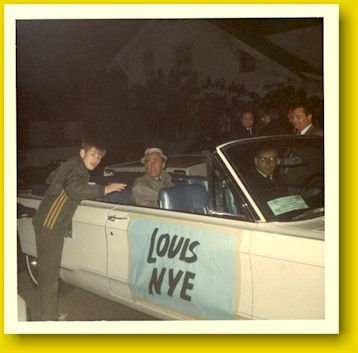
Here's the biggest sourpuss of the evening, Louis Nye, a fussy character actor from the Sixties who, as I recall, had a mean persona something like Paul Lynde's. "Mr. Nye? Excuse me. Could you look at my friend holding the camera, please? Mr. Nye?" His probable response: "Get lost, kid." This was Christmas, for Pete's Sake... where's the Christmas spirit?
Note that my jacket has three yellow racing stripes.

And finally, I approach the presence of the Parade Grand Marshal, Bing Crosby, who looks about as filled with the spirit of the season as Nye. He sits on a (probably hard as a rock) chair covered with gold foil, mounted on a float that looks like it was dragged out for reuse from a St. Valentine's Day parade. Merry Christmas, everyone, bow-bow-be-do-bow-boooowww...
 One photo I do not have that I sincerely wished I did is of Kathy Garver, "Sissy" on the then-current TV show Family Affair. Possessor of an incredible flip outdoing even Diana Rigg's, I was able to talk to her briefly when she was preparing to board her float. I recall looking down her low-cut dress all the while.
One photo I do not have that I sincerely wished I did is of Kathy Garver, "Sissy" on the then-current TV show Family Affair. Possessor of an incredible flip outdoing even Diana Rigg's, I was able to talk to her briefly when she was preparing to board her float. I recall looking down her low-cut dress all the while.
Jimmy and I parted company about the time we both started junior high school in 1968. I suppose that the challenge of attending seven different classes each day kept us mentally busy enough so that we didn't really need each other's company the way we did before. I remember the last sleepover at my house; we got really stupid throwing a stuffed bear around and I captured this in a Captain Russian comic - our hero takes on a cigar-smoking gangland boss who talks tough and looks like a stuffed bear. There was one brief meeting in 1969 when Dad and I were doing a Sunday drive and, oddly enough, a chance encounter at Disneyland in 1978. Then no contact at all.
I Jimmy had graduated from Hollywood High School, but phone calls there led nowhere. It took Avocado Memories and the Internet to link us again. For a number of years I put a link on the top of the main page describing who I was and asking questions that described Jimmy. An electronic message in a bottle, so to speak. And sure enough, one day in 2001 I got an e-mail from him. His wife was browsing the Internet and came across Avocado Memories on a recommendation from a friend. She saw the link, printed out the text and woke Jimmy early in the morning asking, "Is this you? Did you know a Wes Clark when you were a kid?"
Jimmy has a movie buff's dream job: he works as a projectionist at the UCLA Film School. On a vacation to Los Angeles in 2004, I met him after 26 years.
The funny thing is, after all these years I still sometimes have dreams of wandering around on Hollywood Boulevard. They're faint and indistinct, but the general sense is that I'm young, free, and exploring places where surprises and interesting things are to be found down every street and around every corner.
NOTE: Jimmy adds the following: "This brings back a lot of memories. It's funny, but most of my memories from when we lived next to each other takes place over at your house, and I'm always a little surprised when you talk about what we did over at my home. Also, I don't know if you remember, but there was a place on Hollywood Blvd. called "The Cave." It was sort of a bar/not-quite-strip joint, but the outside had a huge spider web and skull and bat. (I think it's this place called here "the Haunted House." - Wes) The corny horror motif was of some interest to a kid, but for years I was a bit confused about what went on inside. This place was featured in a film called "Girl in the Gold Boots," which, believe it or not, I think is available on DVD. Mystery Science Theater also did their usual number on this film, and I remember how surprised I was to see The Cave featured, along with some shots of Hollywood Blvd. from the mid-sixties."
I am very sorry to report that Jimmy died in 2018.
75-Year Hollywood Tradition Ends
By Associated Press
March 22, 2007
LOS ANGELES -- The curtain has closed on a Hollywood tradition.
Officials announced Wednesday that after 75 years, the Hollywood Christmas Parade has been canceled due to rising costs and loss in revenue.
"This is a very difficult thing for us to have to do," said Jeff Briggs, chairman of the Hollywood Chamber of Commerce's board of directors. "We're disappointed and sad. But we're out of the parade business."
The chamber started the parade in 1928 to lure shoppers to Hollywood Boulevard by decorating it with live trees and Christmas ornaments. It grew in size and crowds over the years, attracting people who wanted to see movie stars ride on elaborate floats.
Bing Crosby, James Stewart, Ronald and Nancy Reagan, Charlton Heston and Natalie Wood were among those who took part in the parade through the years. Singing cowboy Gene Autry was a major parade supporter.
But in recent years, the parade struggled to attract celebrity participants and a national television audience.
The chamber, which is supported by member dues, said it lost about $100,000 in producing last year's $1 million event.
Johnny Grant, the honorary mayor of Hollywood who ran the parade for 22 years, said he was heartbroken to see the parade end. Last year's parade was his last as executive producer.
"When that last float went down the street last year, half my life went with it," he said. "But L.A.'s changing, America's changing. The public has many more entertainment platforms now."